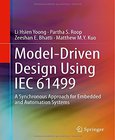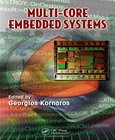Software Development for Embedded Multi-core Systems
A Practical Guide Using Embedded Intel Architecture

Book Details:
| Publisher: | Newnes |
| Series: | Newnes , Embedded |
| Author: | Max Domeika |
| Edition: | 1 |
| ISBN-10: | 0750685395 |
| ISBN-13: | 9780750685399 |
| Pages: | 440 |
| Published: | Apr 28 2008 |
| Posted: | Nov 19 2014 |
| Language: | English |
| Book format: | |
| Book size: | 6.21 MB |
Book Description:
The multicore revolution has reached the deployment stage in embedded systems ranging from small ultramobile devices to large telecommunication servers. The transition from single to multicore processors, motivated by the need to increase performance while conserving power, has placed great responsibility on the shoulders of software engineers. In this new embedded multicore era, the toughest task is the development of code to support more sophisticated systems. This book provides embedded engineers with solid grounding in the skills required to develop software targeting multicore processors. Within the text, the author undertakes an in-depth exploration of performance analysis, and a close-up look at the tools of the trade. Both general multicore design principles and processor-specific optimization techniques are revealed. Detailed coverage of critical issues for multicore employment within embedded systems is provided, including the Threading Development Cycle, with discussions of analysis, design, development, debugging, and performance tuning of threaded applications. Software development techniques engendering optimal mobility and energy efficiency are highlighted through multiple case studies, which provide practical "how-to advice on implementing the latest multicore processors. Finally, future trends are discussed, including terascale, speculative multithreading, transactional memory, interconnects, and the software-specific implications of these looming architectural developments. Table of ContentsChapter 1 - Introduction Chapter 2 - Basic System and Processor Architecture Chapter 3 - Multi-core Processors & Embedded Chapter 4 -Moving To Multi-core Intel Architecture Chapter 5 - Scalar Optimization & Usability Chapter 6 - Parallel Optimization Using Threads Chapter 7 - Case Study: Data Decomposition Chapter 8 - Case Study: Functional Decomposition Chapter 9 - Virtualization & Partitioning Chapter 10 - Getting Ready For Low Power Intel Architecture Chapter 11 - Summary, Trends, and Conclusions Appendix I Glossary References *This is the only book to explain software optimization for embedded multi-core systems*Helpful tips, tricks and design secrets from an Intel programming expert, with detailed examples using the popular X86 architecture*Covers hot topics, including ultramobile devices, low-power designs, Pthreads vs. OpenMP, and heterogeneous cores
Download Link:
Related Books:
Mission-Critical and Safety-Critical Systems Handbook
Design and Development for Embedded Applications
This handbook provides a consolidated, comprehensive information resource for engineers working with mission and safety critical systems. Principles, regulations, and processes common to all critical design projects are introduced in the opening chapters. Expert contributors then offer development models, process templates, and documentation guidelines from their own core critical applications fields: medical, aerospace, and military. Readers will gain in-depth knowledge of how to avoid common pitfalls and meet even the strictest certification standards. Particular emphasis is placed on best practices, design tradeoffs, and testing procedures. *Comprehensive coverage of all key concerns for designers of critical systems including standards complianc...
Model-Driven Design Using IEC 61499
A Synchronous Approach for Embedded and Automation Systems
This book describes a novel approach for the design of embedded systems and industrial automation systems, using a unified model-driven approach that is applicable in both domains. The authors illustrate their methodology, using the IEC 61499 standard as the main vehicle for specification, verification, static timing analysis and automated code synthesis. The well-known synchronous approach is used as the main vehicle for defining an unambiguous semantics that ensures determinism and deadlock freedom. The proposed approach also ensures very efficient implementations either on small-scale embedded devices or on industry-scale programmable automation controllers (PACs). It can be used for both centralized and distributed implementations. Significantly,...
Multi-Core Embedded Systems
Details a real-world product that applies a cutting-edge multi-core architecture Increasingly demanding modern applicationssuch as those used in telecommunications networking and real-time processing of audio, video, and multimedia streamsrequire multiple processors to achieve computational performance at the rate of a few giga-operations per second. This necessity for speed and manageable power consumption makes it likely that the next generation of embedded processing systems will include hundreds of cores, while being increasingly programmable, blending processors and configurable hardware in a power-efficient manner. Multi-Core Embedded Systems presents a variety of perspectives that elucidate the technical challenges associated with such increa...
2007 - 2021 © eBooks-IT.org



